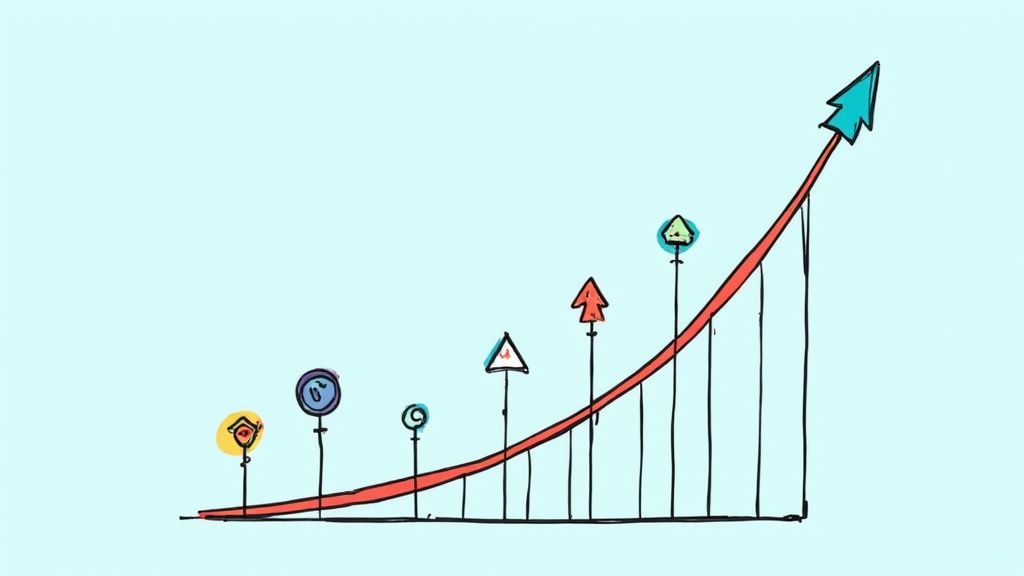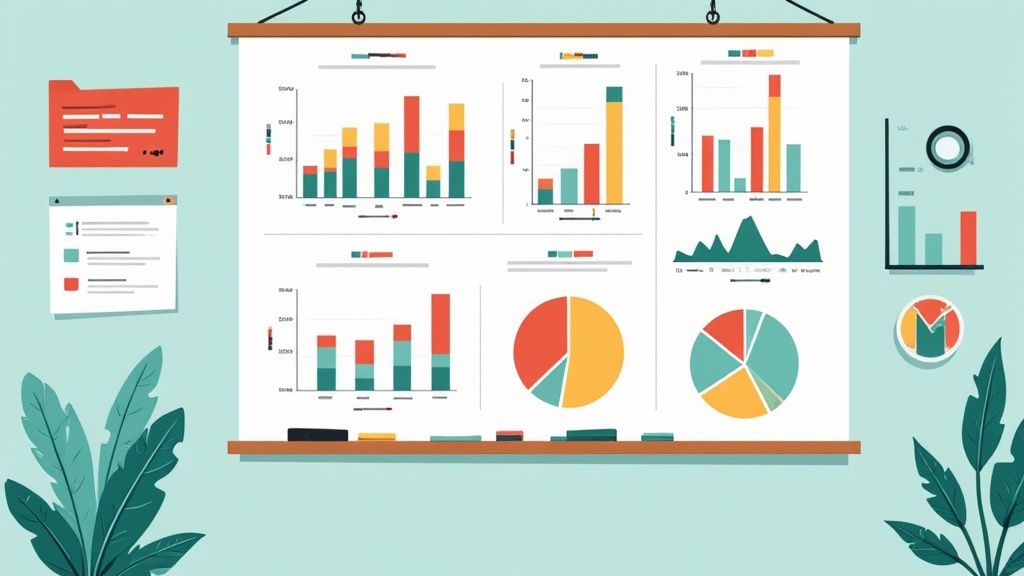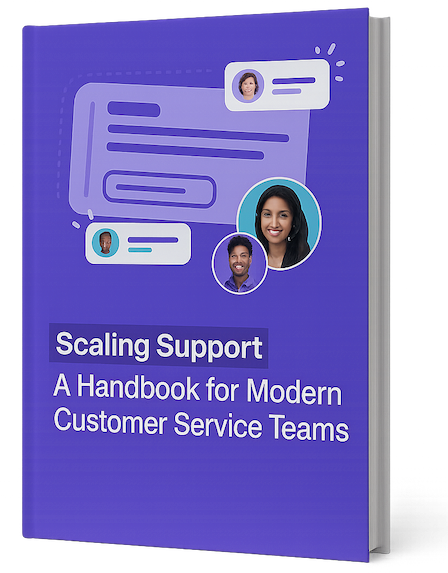Making Sense of Customer Satisfaction Measurement

Understanding how customers feel about your business goes beyond simple survey data. When measuring customer satisfaction, the goal is to uncover what drives those scores and identify meaningful patterns. A high rating alone doesn't guarantee customer loyalty, just as a low score may not fully explain what needs improvement. That's why having robust measurement systems is essential.
Understanding the Nuances of Customer Satisfaction Scoring
Smart businesses take a thoughtful approach to measuring satisfaction by looking at multiple data points. One key distinction is between transaction-specific feedback and relationship-level sentiment. Transaction surveys capture reactions to individual interactions like purchases or support calls. Relationship surveys assess how customers feel about the overall brand experience. Using both provides a complete picture of customer perceptions.
Key Methods for Customer Satisfaction Scoring
Businesses commonly use several proven methods to track customer satisfaction:
- Customer Satisfaction Score (CSAT): Measures satisfaction with specific interactions or products using a five-point scale from "very dissatisfied" to "very satisfied"
- Net Promoter Score (NPS): Evaluates customer loyalty by asking likelihood to recommend on a 0-10 scale, grouping responses as promoters, passives, or detractors
- Customer Effort Score (CES): Assesses how easy it was for customers to accomplish their goals, with lower scores indicating less effort needed
| Method | Focus | Scale |
|---|---|---|
| CSAT | Transactional Satisfaction | 1-5 (or similar) |
| NPS | Customer Loyalty | 0-10 |
| CES | Ease of Interaction | Varies (e.g., 1-7) |
Beyond quantitative metrics, gathering open-ended feedback through surveys and customer interviews adds crucial context about the "why" behind the numbers. For example, the American Customer Satisfaction Index (ACSI) provides valuable industry benchmarks – as of Q3 2024, the national ACSI score is 77.9 out of 100, showing the current state of customer satisfaction in the US.
Selecting the right mix of measurement methods is key for gaining practical insights. By combining various techniques and focusing on understanding what drives scores, companies can use satisfaction data to make meaningful improvements that benefit both the business and its customers.
Building a Scoring System That Actually Works
Creating an effective customer satisfaction scoring system requires more than collecting numerical ratings. You need to understand the deeper meaning behind customer responses. While we covered CSAT, NPS, and CES earlier, here we'll focus on building a framework that meaningfully captures and analyzes customer feedback.
Defining Your Objectives and Key Performance Indicators (KPIs)
Start by getting clear on what matters most for your business. Do you want to improve support interactions? Increase how often customers use your product? Build stronger customer loyalty? Your specific goals will determine how you structure your scoring approach. Once you identify these objectives, choose KPIs that directly map to them.
Crafting Effective Survey Questions
Your questions form the foundation of your scoring system. Rather than broad queries like "How was your experience?", ask about specific touchpoints. For example: "How satisfied were you with the checkout process speed?" or "How well did our support team resolve your issue?" These targeted questions provide clear insights into where you can improve.
Establishing Reliable Measurement Scales
For your scoring to work, you need consistent measurement. Whether you use a 1-5, 1-7, or 0-10 scale, apply it uniformly across surveys so you can track trends accurately. Clearly explain what each rating means – for instance, on a 1-5 scale, define that 1 means "very dissatisfied" and 5 means "very satisfied." This helps customers rate consistently. Think of it like a recipe – you need standard measurements to get reliable results.
Combining Quantitative and Qualitative Feedback
Numbers tell part of the story, but comments provide crucial context. After asking scaled questions, include open-ended follow-ups like "What could we do to improve your support experience?" This mix of ratings and written feedback gives you a complete picture of customer sentiment. Just as doctors use both test results and patient descriptions to diagnose issues, effective scoring systems need both types of data. Research shows that analyzing multiple feedback types leads to more accurate understanding and more targeted improvements.
This structured approach to satisfaction scoring equips you with actionable insights to enhance customer experience. By understanding both the scores and the reasons behind them, you can make meaningful changes that address root causes rather than symptoms.
Turning Raw Data into Actionable Intelligence

A robust customer satisfaction scoring system provides the foundation for gathering valuable feedback data. However, the real value comes from analyzing and interpreting that data effectively. Rather than just calculating basic averages, successful companies dig deeper into customer feedback to uncover meaningful insights. Let's explore how organizations can turn raw feedback data into action.
Identifying Patterns and Emerging Trends in Customer Satisfaction Scoring
Finding meaningful patterns in customer satisfaction data requires looking beyond surface-level metrics. For instance, are specific product features consistently mentioned in negative reviews? Do certain customer segments report lower satisfaction? By examining data through multiple lenses – demographic, time-based, product-specific – you can spot concerning trends early. This detailed analysis helps identify which areas need immediate attention and allows you to track how satisfaction levels shift after product launches, marketing campaigns, or service changes. Through ongoing monitoring, you can catch potential issues before they become major problems.
Separating Significant Signals From Statistical Noise
Not every change in satisfaction scores carries equal weight. Like a doctor interpreting test results, you need to determine which fluctuations matter and which are just normal variation. For example, while a single negative review may not indicate a systemic issue, multiple complaints about the same feature warrant investigation. Statistical analysis techniques help identify truly meaningful changes in customer satisfaction versus random variation. This focused approach ensures you invest resources in addressing real problems rather than chasing statistical anomalies.
Transforming Data into Actionable Strategies
The end goal is using satisfaction data to drive positive change throughout your organization. When analysis reveals specific issues – like long wait times frustrating customers – you can implement targeted solutions such as adding support staff or creating self-service options. This often requires collaboration across departments. For example, sharing usability feedback with product teams helps inform future development. According to the latest American Customer Satisfaction Index of 77.9 (Q3 2024), companies must continuously work to improve customer experiences to stay competitive. Taking this systematic approach to analyzing satisfaction data enables businesses to deeply understand their customers and use those insights to fuel growth. In the next section, we'll explore how to connect these satisfaction scores to concrete business outcomes.
Connecting Scores to Business Results
While measuring customer satisfaction gives you important data, the real value comes from connecting those scores to clear business outcomes. Companies need to prove how improved satisfaction translates into stronger financial results. The most effective organizations focus on showing exactly how their customer experience investments pay off through satisfaction metrics.
Demonstrating ROI Through Customer Satisfaction Scoring
The most direct way to show value is by tying specific score improvements to key business metrics. Take a business that rolls out better onboarding and sees CSAT jump 10 points – they can track if those more satisfied customers end up spending more over time. When satisfaction gains clearly lead to revenue growth and lower churn, it validates investing in customer experience. This evidence helps justify continued focus on satisfaction.
Building a Business Case With Satisfaction Data
Satisfaction data provides concrete support when requesting resources for customer experience projects. For example, when proposing a new support tool, you can highlight how current low satisfaction scores contribute to customer losses. By connecting poor satisfaction to specific revenue impact, you create a much more persuasive argument for making improvements.
Linking Satisfaction to Revenue and Other KPIs
Success requires a solid framework for connecting satisfaction metrics to business performance. Teams should analyze correlations between CSAT trends and repeat purchases, or compare the revenue impact of detractors versus promoters. These analyses reveal satisfaction's direct effect on financial results. This shows that measuring satisfaction isn't just about making customers happy – it directly impacts the company's success.
Practical Frameworks For Connecting Scores and Results
Several proven methods can help establish these connections:
- Regression analysis: Using statistics to determine how satisfaction scores (independent variable) relate to metrics like revenue or churn (dependent variables)
- Customer lifetime value analysis: Breaking down how much highly satisfied versus dissatisfied customers spend over time
- Controlled experiments: Testing different approaches and measuring impact on both satisfaction and business metrics
With these frameworks in place, organizations move beyond simple score tracking to showing clear business value. This positions customer experience as a strategic investment rather than just a cost center. Given the current national ACSI score of 77.9, companies must prove satisfaction's worth to justify continued investment in customer experience improvements.
Implementing Your Scoring Strategy

Having a customer satisfaction scoring system is essential, but making it work effectively requires careful implementation. From training your team members to establishing consistent processes, each step matters in creating a system that delivers real value. Let's explore the key steps to put your scoring strategy into action.
Training Your Team on Effective Customer Satisfaction Scoring
Success starts with proper training. Your team needs to understand both the mechanics of collecting scores and the reasons behind the process. For instance, customer service agents should learn how to clearly explain the scoring system to customers and encourage their participation. When team members see how their daily actions impact satisfaction scores, they become more invested in improving the customer experience. This personal connection helps build a customer-focused culture across your organization.
Establishing Consistent Measurement Protocols
Getting reliable data requires consistent measurement practices. This means having clear rules about when and how to gather feedback. Some key decisions include determining the best timing for surveys – right after an interaction or a few days later – since this can significantly affect the responses you receive. You'll also want to keep your question wording and scoring scales the same across all customer touchpoints. Think of it like taking regular temperature readings – you need to use the same thermometer and process each time to track meaningful changes.
Creating Feedback Loops That Drive Continuous Improvement
Collecting scores is just the beginning. The real value comes from analyzing that feedback and using it to make positive changes. Regular review sessions help identify patterns that point to areas needing improvement. For example, if customers consistently give low scores for a specific product feature, share that insight with your product team so they can address the issue. By closing this feedback loop, you create an environment where customer input directly shapes improvements.
Overcoming Common Implementation Challenges in Customer Satisfaction Scoring
Every new system faces some hurdles during implementation. One frequent challenge is getting everyone on board with the process. You can address this by showing how satisfaction scores connect to business results, as we covered earlier. Data quality is another common concern – regular audits of your collection process help ensure accuracy. Tools like SupportMan can make data gathering and analysis smoother, especially when integrated with communication platforms like Slack. Your scoring approach should also grow with your organization, which might mean adding new methods or refining existing ones over time. With the current national ACSI score at 77.9, maintaining strong customer satisfaction requires ongoing attention and adjustment to stay competitive.
Preparing for the Next Evolution in Satisfaction Measurement

To stay ahead, businesses must do more than just link customer satisfaction scores to their bottom line – they need to adapt to new ways of understanding and measuring customer experiences. As customer needs change, measurement approaches must evolve to capture deeper insights.
Integrating Artificial Intelligence into Customer Satisfaction Scoring
Artificial intelligence is changing how we collect and analyze customer feedback. For example, AI sentiment analysis can now scan open-ended survey responses to identify patterns in customer emotions and concerns. This provides richer context beyond simple ratings. AI also enables dynamic surveys that adapt their questions based on previous responses, helping uncover specific issues that might otherwise go unnoticed.
Leveraging Real-Time Analytics for Immediate Action
Quick access to customer feedback data is essential for making timely improvements. Rather than reviewing satisfaction scores weeks or months later, teams can now monitor feedback as it arrives. For instance, if several customers express frustration with a particular product feature, the system can immediately alert relevant teams to investigate and resolve the issue. This rapid response helps prevent small problems from becoming major sources of dissatisfaction.
Exploring Innovative Data Collection Methods
While traditional surveys remain valuable, new approaches are expanding our view of customer sentiment. Social media monitoring reveals unsolicited feedback about brands and products. Website analytics show how customers interact with digital touchpoints, highlighting both smooth experiences and pain points. Combining these diverse data sources with standard satisfaction metrics provides a more complete picture of the customer journey.
Maintaining Reliability in the Age of Innovation
As teams adopt new measurement tools, maintaining accurate and consistent data remains crucial. New approaches need careful testing to ensure they provide reliable insights. Companies should focus on smoothly connecting new and existing systems to create a unified view of customer satisfaction. This balanced approach helps drive real improvements while protecting data quality. With the U.S. customer satisfaction benchmark at 77.9, businesses must thoughtfully use every available tool to boost satisfaction and outperform competitors.
Streamline your customer satisfaction scoring and turn feedback into action with SupportMan. Integrate Intercom ratings directly into Slack for real-time insights and team collaboration. Start your free trial today at https://supportman.io.


